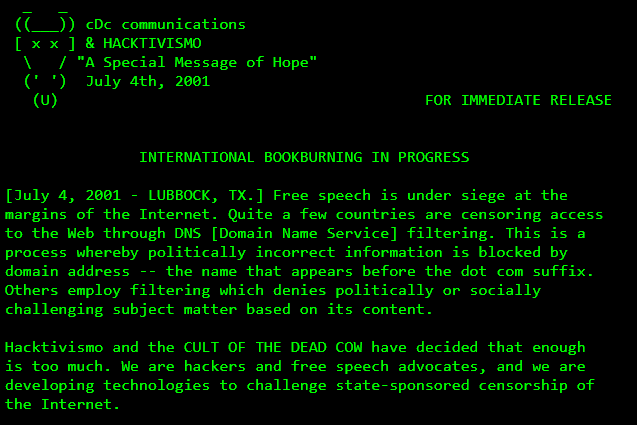
The term “hacktivism” is a combination of the English terms “hacking” and “hacktivism” and was coined to describe the use of computer hacking for political or social purposes.
It is a complex phenomenon involving hacker groups and activists, often operating at an international level, who use hacking techniques to promote ideas or protest against governments, institutions or multinationals.
The motivations of hacktivists can be multiple, but almost always linked to political, social or ethical ideals, or to specific events or increasingly to situations of national crisis.
In this article we will explore what cyber hacktivism is, starting from its history and the declaration of hacktivism by the “Cult of the Dead Cow”, then moving on to the techniques, consequences and its evolution and finally talking about the “Cyber Militias”.

Cyber hacktivism is distinguished from traditional hacking by the political or social goals that motivate it. Typically, hacktivists seek to use their cyber skills to promote a cause or protest a political or economic decision they deem unjust. In this way, hacktivists position themselves as opponents of the established order and seek to radically influence society.
Cyber hacktivism has been the subject of many high-profile actions in recent years. Among the most well-known are the activities of the group Anonymous, founded in the United States in 2003 and known for its operations against governments and organizations it deemed guilty of abuse or corruption. Anonymous has been involved in numerous protests, including supporting the Arab Spring and denouncing human rights abuses in various countries around the world.
In short, cyber hacktivism is a form of protest and activism that uses hacking techniques to gain visibility and promote a political or social agenda. It is a complex and diverse phenomenon, involving groups of hackers and activists around the world. In the next sections of our article, we will analyze the history and evolution of cyber hacktivism, its motivations, the forms of protest used, and the consequences for societies and institutions.
Cyber hacktivism has a long and complex history that dates back to the 1980s, when the first hacker groups began to use hacking techniques for political and social purposes.
One of the first groups to use hacking techniques for political purposes was the Chaos Computer Club (CCC), founded in Germany in 1981. The CCC defined itself as a group of “ethical” hackers who sought to use their computer skills to promote freedom of expression and the right to privacy. The CCC organized numerous conferences and events to promote its ideals and contributed to the spread of hacker culture throughout the world.
Later in 1984 the “Declaration of Hacktivism” was drafted by the hacker group Cult of the Dead Cow (CdC) which we will see in the next chapter.
In the 1990s, cyber hacktivism gained greater visibility thanks to the actions of the Electronic Disturbance Theater (EDT) group, founded in the United States in 1998. EDT stood out for its hacking “performances,” which consisted of organizing Distributed Denial of Service (DDoS) attacks against websites of government or corporate organizations deemed responsible for abuse or injustice.
Throughout the 2000s, cyber hacktivism continued to evolve and spread throughout the world. One of the best-known groups is Anonymous, founded in the United States in 2003 and known for its protests against governments and organizations deemed guilty of abuse or corruption. Anonymous has used hacking techniques to promote a wide range of causes, including free expression, the fight against corruption, and the right to privacy.
In short, cyber hacktivism has deep roots in the hacker culture of the 1980s and 1990s, when groups first began using hacking techniques for political and social ends. Over the years, cyber hacktivism has continued to evolve and spread across the globe, becoming a complex and diverse phenomenon involving hacker groups and activists around the world.
The Cult of the Dead Cow Hacktivism Statement is a historical document of cyber hacktivism that has had a significant impact on hacker culture and digital activism. The CDC was founded in the United States in 1984 and was one of the first hacker groups to define themselves as “ethical” and to advocate the use of their computer skills for social and political ends.
The CDC’s Hacktivism Statement was published in 1996 and was one of the first official statements to endorse hacktivism as a legitimate form of political protest. In the document, CDC members stated that“hacktivism is a form of political expression that uses computer skills to communicate messages of protest and resistance.”

The Declaration of CDC Hacktivism has had a significant impact on hacker culture and digital activism. It has helped legitimize the use of hacking techniques for social and political ends and has inspired many other hacktivist groups around the world.
It’s important to note that cyber hacktivism can be a complex and controversial practice. While some see it as a legitimate form of political protest, others consider it a form of cybercrime. In any case, the CDC’s Hacktivism Statement has helped spark a debate about the role of hacktivism in society and its ethical and legal implications.
Cyber hacktivism is often motivated by political, social, or ethical ideals. Hacktivists may use their cyber skills to promote freedom of expression, the fight against corruption, the defense of human rights, and the protection of privacy.
In some cases, hacktivists may also be motivated by more specific causes. For example, during the war between Ukraine and Russia, the Ukrainian hacker group known as “CyberBerkut” organized numerous cyber attacks against Russian websites, protesting Russia’s annexation of Crimea and the Russian government’s support for Ukrainian separatists.
Russia did the same thing using hacker collectives such as “Killnet” and “Noname057(16)“, who repeatedly attacked Western targets that supported Ukraine, where many of these attacks also hit Italy.
However, it should be emphasized that cyber hacktivism can also be used for illicit and malicious purposes. Cyber attacks can cause economic damage and compromise the security of the people and organizations involved. Therefore, it is important to distinguish between “ethical” hacktivism and illegal or criminal hacktivism.

The hacktivist group Anonymous is one of the most well-known and influential groups in the world of cyber hacktivism. The group was founded in 2003 by a group of users on the 4chan forum, with the aim of protesting the Church of Scientology and its policy of internet censorship. Since then, the group has carried out numerous protests and cyber attacks against organizations and governments around the world.
Anonymous is known for using a mask depicting the character of Guy Fawkes, taken from the comic book and film “V for Vendetta” as a symbol of its activity. The mask represents anonymity, one of the group’s core principles.
Anonymous’s actions include Operation Payback, in which the group attacked the websites of several organizations, including the RIAA and the MPAA, in protest of restrictions on file-sharing, and Operation Chanology, against the Church of Scientology.
But not all of Anonymous’s actions have been targeted against organizations or governments. The group has also conducted advocacy activities, such as when it launched Operation Safe Winter to help the homeless during the winter.
One of the most interesting features of Anonymous is its decentralized and leaderless structure. The group has no formal leader or hierarchy, but organizes itself through a variety of internet channels, such as IRC and social media. This structure makes it difficult for authorities to identify and stop Anonymous activists.
Furthermore, the group is known for using sophisticated hacking techniques and its ability to penetrate the computer systems of organizations and governments. Anonymous has also developed a wide range of hacking tools, such as LOIC (Low Orbit Ion Cannon), software used to carry out DDoS attacks.
In short, Anonymous is one of the most well-known and influential hacktivist groups in the world, known for its protest actions and cyber attacks. Its decentralized structure and use of sophisticated hacking techniques make it a difficult adversary for authorities to detect and stop.
Cyber hacktivism can take many different forms. Here are some of the most common ones:
In conclusion, cyber hacktivism is a phenomenon that takes different forms depending on the causes, motivations, and objectives of the hacktivists involved.

Cyber hacktivism is a phenomenon that has spread throughout the world, thanks to the spread of the Internet and information technology. Hacktivists are present in every country and operate on a global scale, using computer networks to organize protests and denunciation actions.
In recent years, cyber hacktivism has become increasingly widespread throughout the world, thanks to the ease of access to information technology and the growing awareness of citizens on the issues of privacy and freedom of expression.
Some of the most well-known international hacktivist groups include Anonymous, LulzSec and AntiSec, which have attracted media attention for their protest actions against organizations and institutions considered responsible for immoral or illegal behavior.
Cyber hacktivism has also been present in Italy for several years. Among the best-known groups are hackitivisti.net and Anonymous Italia, which have organized several online and offline protests against government policies and restrictions on freedom of expression.
Cyber hacktivism has had a significant impact on societies and institutions around the world. On the one hand, hacktivists have used their cyber skills to protest against organizations and institutions they consider responsible for immoral or illegal behavior. On the other hand, these activities have caused damage to the organizations involved and may violate privacy and cybersecurity laws.
One of the main effects of cyber hacktivism is the spread of information and ideas. Thanks to information technology, hacktivists can communicate and coordinate their activities anonymously, quickly, and effectively, reaching large audiences around the world. This has led to the creation of a new form of activism, capable of overcoming geographical and linguistic barriers and engaging an ever-wider audience.
However, cyber hacktivism can also have negative effects on the organizations involved. Hacktivist activities can cause damage to organizations’ websites and IT infrastructure, resulting in financial and reputational losses. Furthermore, hacktivists can violate the privacy of organizations’ employees and customers, obtaining sensitive information that can be used for malicious purposes.
Cyber hacktivism has also led to the creation of new cybersecurity laws and regulations. Organizations are now required to protect their computer systems from external attacks and prevent the loss of sensitive data. Furthermore, government institutions have introduced new cybersecurity and cybercrime laws to regulate hacktivist activity and prevent the dissemination of sensitive information.

Cybernetic hacktivism has evolved over the years, becoming increasingly sophisticated and organized. Furthermore, new challenges have emerged with the advent of new technologies and the growing awareness of authorities to counter hacktivism.
One of the main evolutions of hacktivism has been the adoption of new techniques and tools. For example, DDoS has become increasingly common, but more sophisticated exploit techniques have also been developed. Furthermore, the use of anonymizing networks like Tor has made it more difficult for authorities to track hackers.
Another recent trend is the organization of cyber hacktivism into more structured and hierarchical groups. These groups have developed a kind of personality cult around their most well-known members and have been able to attract a large number of supporters.
However, the evolution of hacktivism has also brought new challenges. For example, many nations have begun to develop their hacking capabilities to use them as tools of cyber warfare. This has led to a growing militarization of cyber hacktivism, which can be used as a kind of weapon to support national interests.
Furthermore, authorities are becoming increasingly adept at tracking and identifying hackers. This has led to an increase in investigations and sentences for cybercrimes, resulting in a decrease in the level of anonymity and protection for hackers.

Cybernetic hacktivism is a complex and constantly evolving phenomenon, which has demonstrated the ability to have a significant impact on societies and institutions. As we have seen, hacktivism can take many forms, from peaceful online protests to the dissemination of classified information or disinformation, all the way to sabotage or cyberattacks.
As we have previously reported, in recent years, we have witnessed the emergence of “Cyber Militias,” organized and highly specialized hacktivist groups, which can pose a serious threat to the cybersecurity of institutions and businesses. These groups can have various objectives, from political to economic or social.
Furthermore, the recent war between Ukraine and Russia has seen an escalation of cyberattacks from both sides, also involving hacktivist groups. These facts demonstrate that hacktivism is also used for national, as well as political or social, purposes.
Despite the positive effects of cyber hacktivism, such as disseminating information or denouncing injustices, we must not underestimate the risks it entails, such as violating privacy or compromising cybersecurity. It is important that governments, institutions, and businesses work to prevent and protect themselves from these risks, without compromising freedom of expression and transparency.
In conclusion, cyber hacktivism remains a constantly evolving phenomenon, requiring constant attention and adaptation from all actors involved. The future of hacktivism will depend on the choices that society and institutions make in the coming years, but it is certain that it will continue to play an important role in digital society.
Follow us on Google News to receive daily updates on cybersecurity. Contact us if you would like to report news, insights or content for publication.
